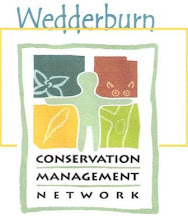
The Box Ironbark ecology course was held again this year between the 4th to the 8th of October at Nagambie in Victoria. Six members of the Wedderburn CMN attended this well respected environmental experience. The following is a brief description of the course taken from a DSE publication followed by a report of one day's activities by a WCMN member.
Extract from a DSE publication
“The Department of Sustainability and Environment (DSE) is convening the popular Box Ironbark Ecology Course this October at Nagambie for the thirteenth consecutive year.
Leading scientists and experts will come together to share up-to-date thinking and research about box ironbark landscapes in changing conditions, focusing particularly on the relationship between soils, plants and animals in these landscapes.
This field based course will emphasise ecological understanding and teach field techniques that improve observation and data collection skills.
“We are pulling together a wide range of people with diverse expertise across the spectrum of box ironbark ecology in this International Year of Biodiversity.
Topics to be explored include landscape management to enable ecological sustainability, biodiversity conservation, soil health assessment and management, and the impact of human use on box ironbark
Extract from WCMN member Report
On arrival we broke into 6 groups with instructions to spend 2 hours walking over a 300 acre Trust for Nature property south of Violet town, and make an inventory (assets and threats). Following this, all groups joined together in the marquee to pool results and discuss a management plan for this property.
We were oriented with a lecture on the theory of land management for ecological restoration.
By the time of the group session to consider actions appropriate for this property, all 30 participants had developed strong and diverse views. Because lunch and packup time was looming the passionate forum had to be shut down before any resemblance to consensus was reached. We were reminded again of the key point in the lecture of the need for an adaptive management strategy ie the management of the property must be constantly monitored and reviewed well into the future".
The following is a description of the history of the property and our inventory.

Over the last 150 years the property has been in turn a gold mine, a dairy farm and a sheep farm. Concurrently it has been a timber/firewood lot. A water course with large red gums lining it runs through the property. The rest is Box Ironbark country with a tiny patch of mallee at the top corner of the property. Significant regrowth is occurring in patches around old vegetation. The cleared part of the property is covered in indigenous grass which is very thin on the upper slopes. There is no real weed problem, probably because the soil is so poor.
Also our leaders suggested that the original pre European top soil was now completely gone so that the current top soil layer was really the second soil layer.
Another perverse inventory item was the dams. Healthy aquatic invertebrate populations were found in the dams and reminded us that the pre gold rush creeks were mainly a series of clear water holes. However we had observed significant overgrazing throughout the property and we decided that the permanent water provided by the dams was supporting excessive kangaroo and rabbit populations which in turn put excessive pressure on the fragile soil. Overall we learned a tremendous amount and this was only the end of the first day – a very worthwhile experience.
Article by Barrie Taylor

No comments:
Post a Comment